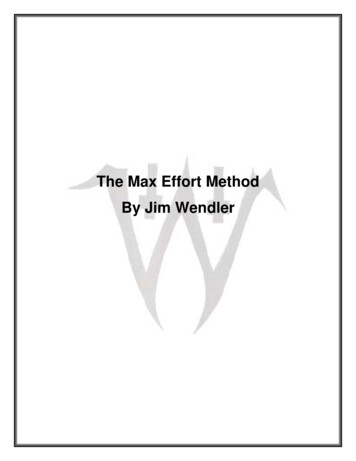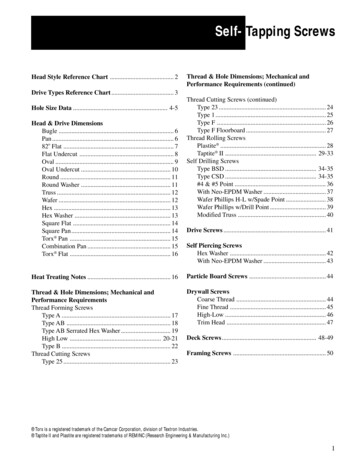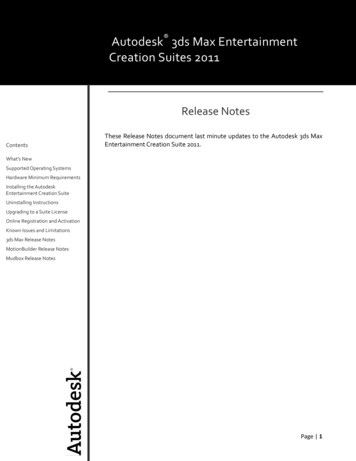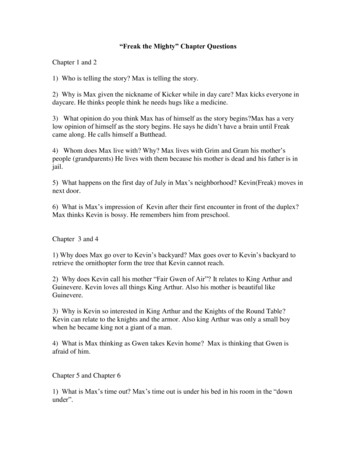
Transcription
The Max Effort MethodBy Jim Wendler
The overman Who has organized the chaos of his passions, given styleto his character, and become creative. Aware of life’s terrors, he affirmslife without resentment.Frederick Nietzsche
Before you embark on any physical fitness program, please consult a doctor.This book may not be reproduced or recorded in any formwithout permission from the author.Copyright 2008 by Jim Wendler. All rights reserved.
AcknowledgementsThis book is dedicated to the Chief.Special thanks to my father, Jim, for all of his time and patience;my mother, Janice, for washing my Eyehategod shirts without question;to Darren Llewellyn for his teaching, coaching, and life support;to Louie Simmons for opening my eyes;and finally to Dave Tate for giving me a chance.
What Is the Max Effort Method?Without getting too complicated, the max effort method is basically lifting amaximal load. This is generally defined as 90 percent plus of one’s maximum.According to Vladimir Zatsiorsky, “The method of maximal effort is consideredsuperior for improving both intramuscular and intermuscular coordination.”Just so we are clear on intramuscular and intermuscular coordination Intramuscular coordination: This is the ability to apply the motor units of amuscle at the same time. No one will be able to recruit 100 percent of the musclefibers, but an advanced athlete will be able to activate many more than abeginner.Intermuscular coordination: This is when different muscles coordinate togetherto make a fluid and efficient movement.So lifting heavy objects helps both of these. That is essentially what the maxeffort method is—lifting heavy stuff.Westside TrainingThe max effort method is obviously not part of one program. You can lift heavythings in any program, and judging by the number of people who I see maxingout on the bench press, it seems to have quite a following.However, the max effort method (at least the term) has become popular in largepart because of Louie Simmons and Westside Barbell. For those who do notknow, Westside Barbell is a powerlifting gym in Columbus, Ohio, and is the home1
of numerous world record holders. Louie Simmons is the owner of WestsideBarbell, and his ideas and innovations in strength training have dramaticallychanged the way the world sees the subject.At the very heart of Westside lies the integration of the dynamic, maximal, andsub-maximal effort methods. When people first began reading about WestsideBarbell and these ideas (and their program), it was quite a kick in the nads. Noone had seen a program that was laid out quite like it, and no one was usingthese kinds of terms. And no one was getting results either.Much has been misinterpreted about Westside training. Because a personautomatically loses 50 percent of their IQ points when on the internet, this newstravels fast and with little regard for the truth. This is because there are manyexperts out there who apparently know about Westside yet have never steppedfoot inside of it. Many people, evenyour so-called strength experts,drop the term “Westside” wheneverthey need some street credentials.And they don’t seem to have aproblem with the fact that they don’teven know what they’re talkingabout.How do I know this? Because Ispent a large portion of my timestudying and learning from LouieSimmons and Dave Tate. And Iactually trained there. So when I speak about the max effort method know that itis in relation to the Westside method or whatever you want to dub this kind oftraining.The Max Effort Method and Westside Training2
To show how one uses the max effort method with Westside training, I’ll first givea brief overview of the Westside method and the standard template. Thestandard template was first introduced in Dave Tate’s article, “The PeriodizationBible, Part I” and is covered extensively in “The Periodization Bible, Part II.” Thiswas the two-part series that made things easier for me and really broke thingsdown. Remember, I didn’t grow up at Westside Barbell. I was probablyintroduced to it the same way that you were—through articles. So if you’re feelingoverwhelmed, don’t worry. We all were/are. Just remember the basic principlesof Westside.They use the following methods: Max effort: Lifting a maximal weight Dynamic effort: Lifting a sub-maximal weight as quickly as possible Repeated effort: Lifting a sub-maximal weight to failureAnd now the dummy version: Max effort: Lifting heavy; maxing out Dynamic effort: Lifting light weights really fast; this is done well beforefailure is ever reached or muscle fatigue is apparent Repeated effort: Lifting like a bodybuilder; get a pumpHere is how the Westside method breaks each of these down during the trainingweek:Sunday: Dynamic effort benchDynamic bench pressTricepsShouldersLats/upper back3
Monday: Max effort squat/deadliftMax effort exerciseHamstringsLow backAbdominalsWednesday: Max effort bench pressMax effort exerciseTricepsShouldersLats/upper backFriday: Dynamic squat/deadliftDynamic squatHamstringsLow backAbdominalsHere is a review of the standard template: two days devoted to the bench press two days devoted to the squat/deadlift two days devoted to dynamic training two days devoted to max effort training four days devoted to repetition trainingNow, let’s review some of the training parameters within this template. For thesake of simplicity, I’ll leave out chains and bands. Everything is going to be donewith straight weight so there will be no confusion about percentages. Plus, I’llleave out stance, grip changes, rest periods, and other similar items. In reality,most of this stuff is inconsequential once you grasp the big picture.4
Bench press parameters for the standard template (dynamic, max effort,and repetition)Dynamic bench press: Eight sets of three repetitions; all sets are performed with55 percent of the raw one repetition max (RM). Rest periods are approximately60 seconds, but personally I’ve never really seen the purpose of this.The whole goal of speed day is to move the bar quickly on the concentric. If youneed to take an extra minute to accomplish the day’s goal, then by all means doso. Many people change their grips with every set. They go from close to mediumto wide. Truth be told, it really doesn’t matter that much. The only reason why Ichanged my grip on this day was to keep track of the number of sets that I wasdoing. Again, remember why you are doing what you are doing.Max effort bench press: This will be discussed at another point in the book.Triceps: One day is devoted to high intensity/low volume triceps work and theother is devoted to low intensity/high volume triceps. For example, high intensitytriceps training could consist of 4- or 5-board presses or rack lockouts. The lowintensity training would be geared toward triceps extensions and push-downs.The day on which you do these is entirely up to you. In my experience, I’vealways had good results putting the high intensity day on dynamic bench day.So you have one day where you work your lockout movement with heavy weight(this is the high intensity day), and you have one day where you become JoeBodybuilder and pump up your arms (this is the low intensity day).Shoulders: This is similar to the triceps because there is a high intensity day anda low intensity day. The high intensity day is technically not high intensity buthigh stress. In this category, I would put dumbbell bench presses, dumbbellincline presses, military presses (with dumbbells or a straight bar), and dumbbellfloor presses. In the low stress category, front raises, side raises, and rear raises5
are good choices. Again, you can choose which day to perform them, but I likeputting the high stress shoulder training on dynamic bench day.One day is devoted to compound pressing exercises with high repetitions. Theother day is geared toward an isolation movement with high repetitions. Youdon’t need a high intensity shoulder day because you’re getting this every timeyou perform a max effort movement.Lats/upper back: Two days are devoted to the lats and upper back, and both aredone with low intensity, high volume. The way that I incorporated this is onSundays, I performed lat work (usually a row or a pull-up) but no upper backwork. On Wednesdays, I did another lat workout (but with a different exercise).My low stress shoulder work consisted of a rear raise, face pull, or a seateddumbbell power clean. So essentially, on the low stress shoulder day, I killed twobirds with one stone—an upper back exercise with a low stress shouldermovement. I did this because I never did front raises or side raises and felt that Igot enough stimulation from my other work. It’s not gospel, but it’s something tothink about.Squat and deadlift parameters for the standard templateDynamic squat: All sets performed on a parallel box. Use a three-week wave withthe following sets and reps: Week 1: 10 X 2 at 50% Week 2: 10 X 2 at 55% Week 3: 10 X 2 at 60%Upon completion of the third week, you simply start the wave over again. Allpercentages are based on your best squat. Let’s disregard equipment at thispoint and say that it’s based on your best 1RM of your box squat wearingwhatever you usually wear on this day. Again, refer to my commentary on6
dynamic bench training regarding rest periods. This is not conditioning. This isspeed work. Save your conditioning for another time.Max effort squat and deadlift: This will be discussed later in the book.Hamstrings: Now, here is where things get tricky. Unlike the shoulders/tricepsroutine of high intensity/low intensity, many people are weak at exercises such asthe glute ham raise. However, they simply need to do the exercise and not worryso much about sets/reps. If you don’t fall into this category, you can do bodyweight glute ham raises on one day, and on the other day, you can add a band ora plate for resistance.Low back: Again, we can’t really isolate the lower back without hitting the glutesand hamstrings. However, you can pick from exercises such as back raises, 45degree back raises, reverse hyperextensions, pull-throughs, and good mornings.Depending on how you do some of these exercises (i.e. with a great amount ofintensity), you can use ONE of these for your hamstring and low back exercise.For example, good mornings can be done for both. If you were to pick reversehyperextensions or pull-throughs, you can get away with doing an extrahamstring exercise.Some people can train their lower back twice a week while others can’t. A goodway to do this is to pick one “easy” exercise (reverse hypers, pull-throughs, unweighted back raises, or band good mornings) for one day and a heavierexercise for the second lower body training day.Abdominals: These are usually trained heavy twice a week in the standardtemplate. Some good exercises to choose from include weighted sit-ups, Romanchair sit-ups, stability ball, hanging leg raises, and side bends. This is not verycomplicated, but you just need to do them. That’s usually the hardest part.7
Please understand that this is only one version of the Westside method. Thereare numerous variations that people have adapted to their own needs. Hell, atWestside, there are variations.However, once you understand the basics of the method—integrating thedynamic, max, and repeated effort—you will understand the Westside method.This is where everyone fails. They bitch and complain about what exercises workbest, how much band tension an average band will give you, and why theRussians know everything (they know this because they grew up in New Jersey),but they haven’t taken the time to figure out the basics of the program. Don’t bethis guy.Max Effort Bench PressBefore we talk about the different exercises for the bench press, let’s addresssome important points.Technique is first. There are many different techniques that one can use. Someof them offer better success than others, but this is only going to be dependanton what works best for you.Here are some simple tips for you to remember:1. Most of your stability is going to be determined on how well you ride up onyour lats and upper back. Think about how much you could bench presswhile lying on a bed as opposed to a hard surface. The bed is much toosoft and so are most people’s lats and upper back. Whenever we doseminars and put people in position to bench, they always say, “I didn’tknow benching hurt this much!”To do this, you must push your upper back and lats together andSQUEEZE. If you are remotely comfortable, you are not squeezing8
enough. Your upper back and lower back should be arched and held inthis position. This does not mean that you should lift your hips off of thebench though. Your butt must stay in contact with the pad.2. When the bar begins its descent, slightly tuck your elbows to the side. Thiswill ensure that the bar touches just below the nipples. This is crucial forpressing power.3. When the bar touches your chest, drive your feet into the ground. Thinkabout squatting the weight up. This needs to be a controlled but violentaction.4. The bar should travel up and back. It should end up slightly over your eyesor mouth.5. Grip width is going to be very individual.6. When you are benching for a heavy set, try to hold your breath for the firsttwo repetitions. This is hard to master, but you will be surprised at muchthis can help once you do it.9
Your grip on max effort day is another widely debated topic. Some peopleadvocate a close grip (fingers around the smooth part of the bar) while othersuse a wider grip. Both will work for a period of time.I did much of my max effort work with a closer grip and got very strong. When Ibegan to stall, I moved my grip out a couple inches and began to make progressagain. In general, I recommend using a medium grip for most people. This stillallows some weight to be moved, but it keeps the strain down on your wrists andshoulders.Board pressBoard pressing is probably the most popular max effort movement for a numberof reasons.1. It works.2. You can handle more weight, thus making it a great overload exercise.And it strokes the ego.3. It’s great for working on sticking points.4. It’s great for limiting the range of motion. This is crucial for those withbanged up shoulders or pectorals.There are many variations with board pressing. Don’t get too wrapped up intrying every variation right away.So what the hell is board pressing?Board pressing is simply bench pressing while a 2 X 6 board rests across yourchest. You bring the bar down to the boards and press back up. The boards areusually 12–20 inches long and are glued or nailed together. If you want to getfancy, many people attach a small handle to the board to make it easier to hold.10
Board pressing usually requires an extra person to hold the board, but it can bedone by you or with just one spotter. Many people put the board underneath theirshirt or use a band or rope to tie it around their chests. This is not the best option,but I did it for years.TechniqueYour board press technique will be about the same as your bench presstechnique. Bring the bar into the board, compress it slightly, and press it back up.One of the major problems with board pressing is the ability to become very goodat it but not necessarily get any better at bench pressing. This is usually a resultof a lifter heaving the bar off of the boards. What this means is that a lifter willuse the board as a slingshot to get the bar started. This isn’t always bad becauseit has been used with success, me included. However, what people neverunderstand is that when their board presses go up but their bench stalls, it maybe because the board press isn’t doing what it’s supposed to do. And it just mightbe the technique that they are using. So remember that.1-board pressThis is kind of the redheaded stepchild of the board pressing family. This isn’tused that much, but I’m not sure why. Well, I know why you can’t handle asmuch weight as with other board presses. This is a great variation for shirted andnon-shirted benchers. This is good for those who can get the bar moving off theirchest for the first few inches but then die out.2-board pressThis is probably the most often used board press for all benchers. This is acommon sticking point for many lifters and is a great way to move some moreweight without it strictly becoming a lockout movement. Most people can 2-boardpress about 102—110 percent of their raw max.11
3-board pressThis is one of my favorite max effort movements only because I’m good at it.Plus, as my 3-board press goes up, so does my shirt bench. A raw bencherprobably doesn’t need to go up any higher than a 3-board. Most people can 3board press about 110—120 percent of their raw max.4-board pressThe 4-board is ashigh as I like to go onmax effort day. Mostpeople will use thisboard assupplemental workfor their lockout, notas a max effortexercise. Still, thismovement finds itselfin heavy rotation in the max effort arsenal of many lifters. Most people can 4board press about 115—125 percent of their raw max. Many times a lifter will usea 4-board to warm up prior to putting on their bench shirt. Additionally, lifters willuse this as a max effort movement and an assistance movement.5-board pressThis isn’t used much for max effort work, but if your arms are long, this can be anacceptable option. Like the 4-board press, this exercise is primarily used as asupplemental movement for lockout work. Also, it can be used for a warm upprior to putting on a bench shirt.A note about the percentages in relationship to your max bench press: Don’tworry about it. If you don’t fall within the percentages listed above, please don’tcommit suicide. It’s not that big of a deal. All it tells you is that you aren’t as good12
at it. The solution? Get stronger. Very few people have strong enough pecs,shoulders, and triceps that they can completely specialize on one aspect of theirlift. Now, if you are a shirt bencher, the technique and lockout is going to becrucial, but you still need strong shoulders and pecs.Board press with bandsThis is one of the best ways to use bands on the bench press. First, it’s a greatway to accommodate the strength curve. And second, it allows you to use bandswithout destroying your pecs and shoulders.Bands have a nasty habit of beating the crap out of you. I have no idea what thebands give at the bottom of the lift (this is up to you to figure out if you reallycare), but here are some numbers for the top of the lift of each band. Remember,these are estimates and are for the bands that are doubled on each side. This isthe combined total weight at the top using one band per side, not counting thebarbell. Mini-band: 60–90 lbs Monster mini-band: 100–120 lbs Light bands: 200–230 lbsPlease remember that if you use light bands forbench pressing, you had better be strong.Setting up the bandsThis is easy. Take one end of the band and put itaround the sleeve of the barbell. Take the otherend and wrap it under your rack, a heavydumbbell (100 lb ), or a band peg. Take the freeend up and place it back around the13
sleeve of the barbell. This is what we call adoubled band.Below is a list of all the possible board presses with bands:1-board with mini bands2-board with mini bands3-board with mini bands4-board with mini bands5-board with mini bands1-board with monster mini bands2-board with monster mini bands3-board with monster mini bands4-board with monster mini bands5-board with monster mini bands1-board with light bands2-board with light bands3-board with light bands4-board with light bands5-board with light bands14
Reverse band bench pressThis exercise is very popular mostly because you canhandle a lot of weight and it somewhat mirrors theeffects of a bench shirt. There are a couple of problemswith doing reverse band presses. Namely, people havea tendency to attach the bands in such a way that theyare pressing a ridiculous amount of weight over theirraw max. So don’t be the guy who attaches a chokedstrong band to the top of a 10-foot rack and yells andscreams about how he can now bench 900 lbs withouta bench shirt.15
You can use light, average, or strong bands for this exercise. I guess you canuse mini-bands, but you might want to check to see if you’re wearing a skirt. Tofigure out how much each band is giving you at the bottom of the bench press,attach the bands and place the barbell in the bands. With the help of a partner (itis crucial that you use a partner with this), place weight on the bar until the bardrops to approximately the same level as your chest. Now you know how muchbar weight is deloaded when the bar is on your chest.It is important that you use bands that are even. Some bands stretch out overtime so be sure to measure them before you use them. My only advice whendoing this exercise is that you set it up the same way each time and use thesame bands when doing so.Board presses with chainsI’m not a big fan of this, but that doesn’t really mean anything. People have usedthis with much success throughout the years so don’t let my bias get to you. Oneof the big questions with this is how to set up the chains for the boards.Normally, we tell the lifter that when he bench presses with chains he shouldhave a full deload of the chains while the bar is on the chest. Of course, thesame logic should apply to the boards, right? Well, the truth is I’m lazy, and I justuse the same set up that I use on a full range bench press for the board presses.Why? Because I know it’s going to be the same every time. However, feel free toadjust accordingly. Obviously, when you get up to the higher boards, less andless chain is going to be moving so you will need a boat load of chain to get anyeffect. Now, you can see why I haven’t bothered with this too much.1-board with chains2-board with chains3-board with chains4-board with chains16
5-board with chainsFloor pressI love floor presses. I think they have done wonders for my raw bench press, andwhen using chains, I think they offer great variation for shirt benchers. There wasa time when I could predict exactly what I could raw bench by my floor press. So,I’m a little biased. Most lifters’ floor press is about 90–92 percent of their rawbench.What I like about floor presses is that they allow for no leg drive, making it a trueupper body movement. If you can floor press more than you can bench press,there are two possible reasons:1. You have no leg drive on the bench press so get working on this.2. You are so skinny that the floor press is akin to a 4-board press so eatsomething.TechniqueYour floor press is going to be similar to your bench press except for two things.First, your elbows are going to touch the floor before the bar hits your chest. Formost people, this will be true. If you have T-Rex arms or a barrel chest, this mightnot be the case. Second, your legs should be straight out in front of you. You canbend your knees, but too many people will drive their feet into the ground and lifttheir ass off of the floor. This is a floor press, not decline presses. So don’t be aturd.Once your elbows touch the floor, pause slightly and press back up. Many peoplewill lower the bar in such a way that their elbows won’t touch at the same time.My advice to you is to lower the bar at a slower pace and make it right. This isn’trocket science.17
Floor press with chains (add weight/add chains)This is one of my favorite exercises. Adding chains to this movement is a greatway to accommodate the strength curve and increase your lockout strength.There are two ways to do floor presses with chains:1. Take a set number of chains and work up by adding bar weight. I usuallyrecommend using two or three chains per side.2. Take a set bar weight and work up by adding chains. Most people will usea bar weight of 185, 225, 275, or 315 lbs.I have done both and can say that the former is better. Plus, not many peoplehave access to a ton of chains so the second option isn’t always feasible.To set up this exercise, take the chain and drape it over the sleeve of the barbell.Make sure the chain is even. You’re ready to press.18
Floor press with bandsI haven’t done this exercise very often but can recognize its worth. Like thechains, the bands accommodate the strength curve and are a great way toincrease your lockout strength. The key to doing this is setting up the mini-bands.To do this, use the same set up as you would when you deadlift against bands(see pictures below in the deadlift section).Floor press board pressThere is a lot of variation here. It’s not a very popular movement though. Floorpress board presses are usually done after one does floor presses. The rack isalready set up so you might as well do some lockout work with some boards.Seriously, this is 99 percent of the reason why people do floor press boardpresses.Full range presses19
So far, we have mostly talked about partial movements for the bench press.Because many people are interested in getting their raw strength up, full rangework is in order. Also, if you compete with a bench shirt, don’t forget to add insome full range work so that you don’t lose low end strength. I didn’t list thebench press as one of the options because it’s not that exciting. However, it canbe used as a max effort exercise.Bench press with chainsI like these for all lifters and think this is a greatmax effort option. Like the floor press with chains,these can be done two ways.1. Take a set number of chains and work up byadding bar weight. I usually recommend usingtwo or three chains per side.2. Take a set bar weight and work up by adding chains. Most people will use abar weight of 185, 225, 275, or 315 lbs.Bench press with bandsFull range bench pressing with bands is great as long as you can handle it. Thissometimes tears up my shoulders and pecs. You can use mini-, monster-mini, orlight bands. Remember, light bands are not for the weak so be careful when youtake the bar off. On a side note, most times people suck when they take out justa bar with bands. The bar is moving all over the place, and they are incrediblyunstable. Usually some added bar weight will stabilize the bar and make the lift alittle easier.20
If you are a raw lifter, don’t be afraid ofusing bands for a short cycle.Incline pressThe incline press doesn’t get a lot of love,but that might be because it’s incrediblyprude in giving results. I used to do thiswhen I first started training this way, and asI got stronger on it, so did my bench press.But those days are gone.Of course, the next question is going to bewhat angle do you use? The answer is whatever you want. Whatever inclinebench you have is fine. When doing inclines, make sure you’re touching yourclavicle with the bar, not your chest. I like to keep the bar as close to my chin aspossible when lowering and raising it. If I bring the bar too low on my chest, itfeels like my shoulders are ripping out. This is not good.Illegal wide bench pressesWhen I was really trying to bring up my raw bench, this exercise seemed to workvery well. An illegal wide bench press is simply doing a bench press with as wideof a grip as you can manage without tearing of your shoulder, pec, or the side ofyour hand on the j-hook of the bench.These are usually done for higher reps (6–10). I usually work up to one big set,saving my energy by keeping the warm-up reps to 3–5. However, you can do itanyway you want. Just make sure that you aren’t going to kill yourself. While thiscan be done as a max effort exercise, many people will use this as an accessorylift.21
RuntsHere are some other max effort exercises that I have used or have seen over theyears. They aren’t used that often, but they might be just the thing you need.Rack presses/rack lockoutsThese can be done from just about any height, which means there is a lot ofvariety. I have done these with bands so don’t be afraid to try somethingdifferent. These are usually done with the bar already on the pins. The lifterpresses from a dead stop. While this might sound good in theory, I have hadmore pec twinges from doing this than with any other bench exercise. I have alsotried taking the bar off normally, lowering it to the pins, pausing, and pressingback up. This pause allows you to store some stretch reflex from the eccentricphase.An important technique point is to gradually build pressure into the bar whenpressing. Don’t slam into the bar because this is how many people get injured.This is the same concept as with deadlifting. You don’t want to violently jerk thebar off the ground. You want to get the slack out of the bar, begin pulling, and22
once the bar starts moving, explode up. This exercise isn’t used that often.However, it’s a great option for those who train alone or for those who train in acommercial gym by themselves and want to make the most commotion possible.There are many theories on using rack presses/lockouts to develop andstrengthen sticking points. It seems like a really good idea though I’ve neverreally seen it work.Cambered bar benchThis bar has long been championed for its benefits of building low end strength. Itis also the championof tearing shit up.This exercise isusually for theyoung, mobile, andpain-free lifters.Basically, you haveabout 2–4 years touse this before youhand it down tosomeone else. Iwould rather use this as assistance work than max effort work.23
Reverse cambered bar benchThis is done by using a cambered bar but turning the camber the opposite way.Instead of the bar giving you a greater range of motion, it now restricts it. This issimilar to a board press or rack lockout. It seems like a good idea, but I couldnever get into it because the bar seemed to move around a lot and the cambertilted. I think this would work better as an assistance exercise, but people haveused it for max effort.Foam bench press (Manpon presses)This is similar to a board press. You lay a piece of foam on
know, Westside Barbell is a powerlifting gym in Columbus, Ohio, and is the home . of numerous world record holders. Louie Simmons is the owner of Westside Barbell, and his ideas and innovations in strength training have









![Dimensions: [mm] Absolute Maximum Ratings (Ambient Temperature 25 C)](/img/56/15412085a9000-1714930.jpg)
